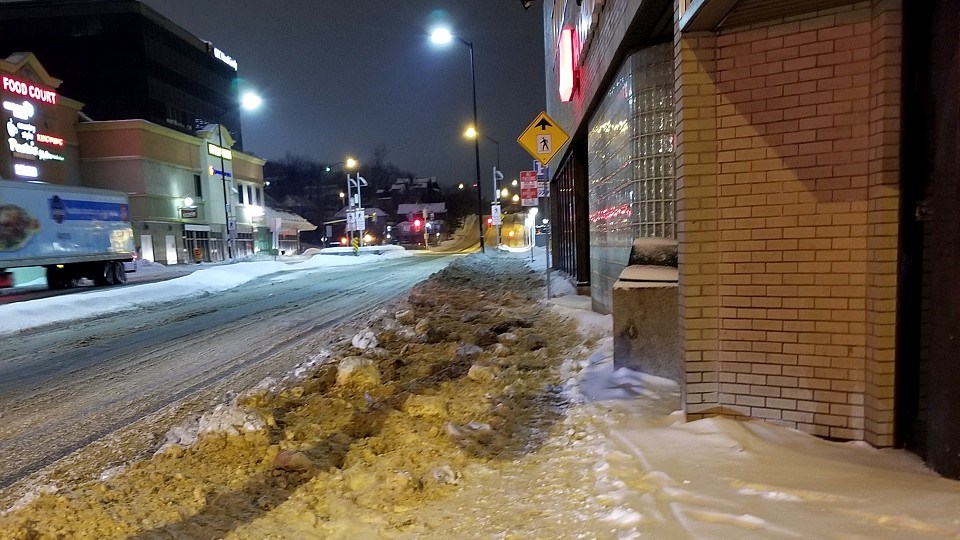“I walk every day and when sidewalks are impassable I walk on the road which is dangerous.”
Welcome to Greater Sudbury Safer Sidewalks’ final column in this series. Here we will outline the specific challenges faced by residents using winter sidewalks, as well as the improvements most requested to address those challenges by respondents, including residents using mobility aids and strollers.
“The city is designed for vehicles and the able-bodied. Those that fall on hard times, experience a very different city. Their lives are further burdened by the current practices/policies. Creating policies/procedures and city planning that accommodates the most vulnerable of our population only makes things better for all.”
The responses from our GSSS Spring 2021 online survey illustrate the challenges experienced by residents in their daily lives while trying to use winter sidewalks. The biggest challenges faced by residents using winter sidewalks are ice and slippery conditions (91 per cent), uneven surfaces (81 per cent), and piles of snow blocking their way (77 per cent).
“Slippery, slushy, or wet (puddles!) sidewalks limit my ability to get groceries and medications. I also cannot get out to just walk, get some exercise/fresh air as it is not safe to do so.”
When sidewalks are not fully scraped clear of snow or ice, the surfaces can get treacherous. Even when temperatures are very low, the daytime sun can melt the snow that remains on the surface. This makes for dangerously slippery conditions: 69 per cent of respondents report water-filled sidewalks as a barrier. Pedestrian tracks on softened snow harden at night making sidewalk surfaces uneven and creating pockets where snowmelt can collect and harden into ice.
“I’m afraid to walk in winter even with cleats on and walking sticks. Because the sidewalk are extremely uneven and slippery”
Even when sidewalks have been plowed, snow from road clearing frequently ends up dumped onto the plowed sidewalks or blocking access to sidewalks at intersections and crossings. This creates impassable and dangerous conditions for pedestrians. In addition, respondents reported that access to cleared bus stops is vital to ensure residents can get to where they need to go.
Pedestrians who use transit are often forced to step into deep snow in order to reach their buses or sidewalks.
“When snowplows push snow from the streets into the sidewalks, and when snow on the sidewalks melts into slush and/or freezes, it makes it more difficult and dangerous for my husband and I — both seniors — to take our daily walks to maintain our good health.”
The most needed improvements identified by residents address these challenges, as well as basic accessibility of sidewalks. These include clearing away ice and slush (95 per cent), adapting to weather conditions (93 per cent), clearing and sanding intersections (89 per cent), co-ordinating road and sidewalk plowing (93 per cent) and clearing away snow knocked into sidewalks (91 per cent), and beginning to plow at 2 cm versus the current standard of 8 cm (79 per cent).
This last was especially important for residents using wheelchairs, mobility aids, or strollers (90 per cent of respondents using a wheelchair, mobility aid or stroller said that plowing at 2 cm would be “most helpful” or “helpful”, reflecting the importance of this improvement to accessibility).
It is clear that people need to use winter sidewalks to get to places they need to go, but feel they and their loved ones are compromising their safety and well-being to do so. In the survey, 49 per cent of respondents (208 people) had fallen on icy sidewalks and been injured; 45 per cent (191 people) often or always are housebound due to poor sidewalk conditions; and 68 per cent (293 people) often or always feel unsafe using sidewalks getting to essential destinations.
Our city needs to do better.
Improvements to winter sidewalk maintenance is essential so that residents can meet their daily needs, move about safely, take care of their mental and physical health, and simply live their lives. That is something we can all support for ourselves, our loved ones, and our fellow community members.
Greater Sudbury Safer Sidewalks is a grassroots group of residents who believes everyone has the right to walk around their neighbourhood and get to where they need to go throughout all seasons. We are working towards positive change to make it safer and easier to get around on foot or with a mobility device in Greater Sudbury. Residents interested in joining or receiving a copy of the survey results can e-mail [email protected] or connect in the Walk Safe Sudbury-Greater Sudbury Safer Sidewalks Facebook group.
